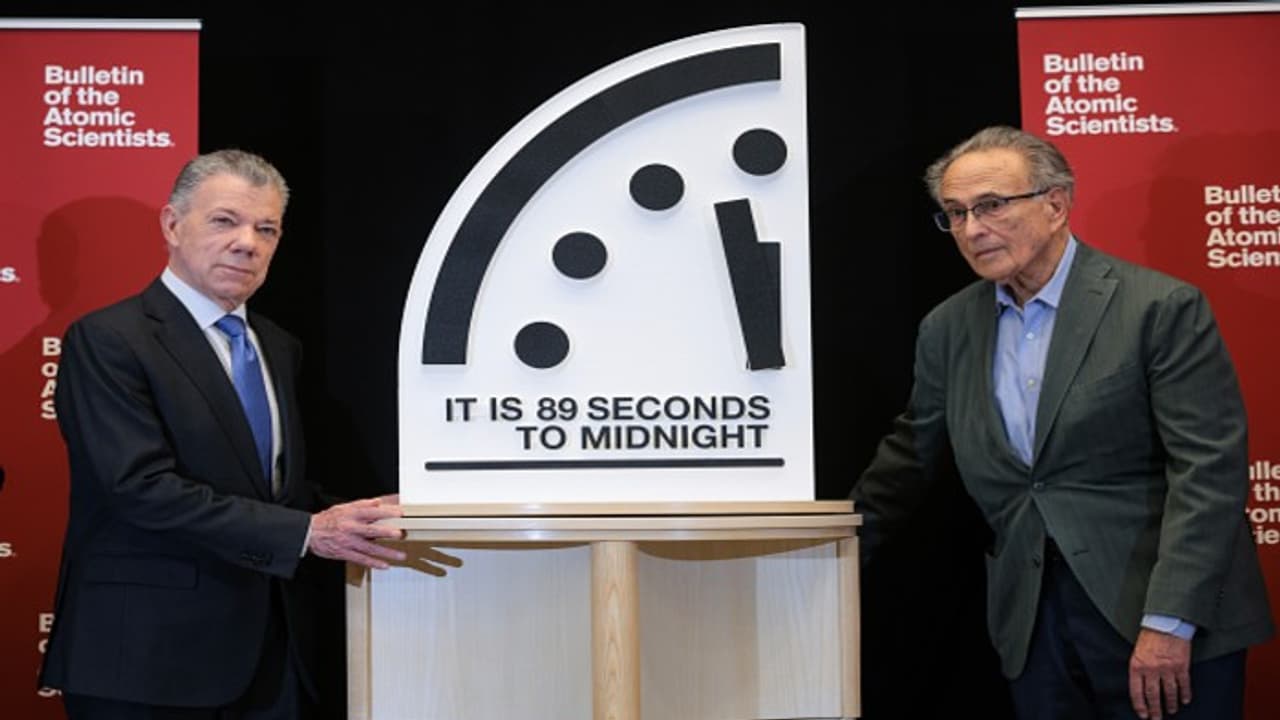Humanity’s countdown to self-destruction just got even shorter. The Doomsday Clock, the chilling gauge of existential threats, has moved one second forward, now set at 89 seconds to midnight - the closest it has ever been in its 78-year history.
Humanity’s countdown to self-destruction just got even shorter. The Doomsday Clock, the chilling gauge of existential threats, has moved one second forward, now set at 89 seconds to midnight - the closest it has ever been in its 78-year history.

Unveiled annually by the Bulletin of Atomic Scientists, the clock serves as a stark reminder of the world's escalating perils. The latest shift, announced on Tuesday, underscores a grim reality- geopolitical chaos, nuclear threats, climate catastrophe, and AI-driven instability are pushing civilization to the brink.
World on the edge
Explaining the update, the Bulletin’s experts cited the Russia-Ukraine war, intensifying Middle Eastern conflicts, nuclear tensions, climate change, the looming bird flu pandemic, and an AI arms race as major reasons behind the shift.
"We set the clock closer to midnight because we do not see sufficient positive progress on the global challenges we face," said Daniel Holz, physicist and board member of the University of Chicago.
"Setting the Doomsday Clock at 89 seconds to midnight is a warning to all world leaders," he added, emphasizing the urgency of global action.
Last year, the clock was set at 90 seconds to midnight, already the most ominous reading since the clock’s inception in 1947. But with rising instability, escalating nuclear threats, and AI-driven disinformation, scientists have determined that humanity’s peril has only worsened.
World spiraling towards chaos
The war in Ukraine, raging since Russia’s invasion in 2022, remains a flashpoint of nuclear anxiety. Experts warn that one miscalculation, a rash decision, or an unintended escalation could trigger a nuclear catastrophe.
"The war in Ukraine continues to loom as a large source of nuclear risk," Holz cautioned. "That conflict could escalate to include nuclear weapons at any moment due to a rash decision or through accident and miscalculation."
Further stoking global instability, Russian President Vladimir Putin recently lowered the threshold for nuclear strikes, broadening the circumstances under which Russia could unleash its vast nuclear arsenal.
Meanwhile, tensions in the Middle East continue to ignite fears of a broader conflict. The ongoing Israel-Gaza war, Iran’s involvement, and China’s military pressure on Taiwan only add to the global tinderbox.
And then there’s North Korea, persistently testing ballistic missiles, flexing its nuclear muscle, and keeping the world on edge.
Beyond warfare and nuclear threats, the planet is also battling an existential environmental crisis. 2023 was the hottest year in recorded history, according to the UN’s World Meteorological Organization, with the last decade consistently breaking heat records.
"While there has been impressive growth in wind and solar energy, the world is still falling short of what is necessary to prevent the worst aspects of climate change," Holz warned.
Extreme weather, rising sea levels, and worsening natural disasters are already reshaping global landscapes—and without immediate intervention, the crisis will spiral further out of control.
The past year has seen staggering advances in artificial intelligence, and with them, an increasingly worrisome potential for military use and mass manipulation.
"Advances in AI are beginning to show up on the battlefield in tentative but worrisome ways," Holz noted. "Of particular concern is the future possibility of AI applications to nuclear weapons."
But beyond warfare, AI-fueled disinformation and misinformation have also emerged as destabilizing forces, eroding trust in institutions and manipulating global narratives.
What is the Doomsday Clock?
A symbol of humanity’s proximity to annihilation, the Doomsday Clock is not just an abstract concept—it’s a scientifically informed measure of existential risk.
First introduced in 1947 during Cold War tensions, it was designed to “frighten men into rationality”, as stated by Eugene Rabinowitch, the Bulletin’s founding editor. Since then, it has moved both forward and backward based on global events, reaching its most distant point—17 minutes to midnight—in 1991 after the end of the Cold War.
But those days are long gone. Today, the world is teetering on the precipice, with no sign of the clock reversing anytime soon.
The Bulletin of Atomic Scientists, composed of leading nuclear experts, climate scientists, and policymakers, meets twice a year to assess global risks and determine the clock’s position. This year, their conclusion is crystal clear- humanity is closer than ever to catastrophe.
